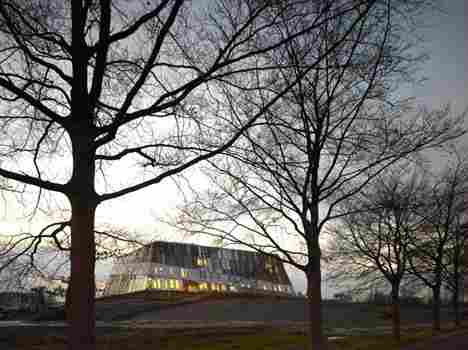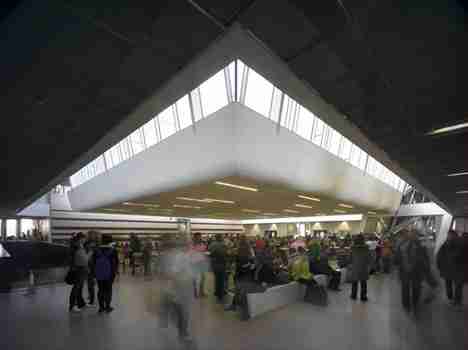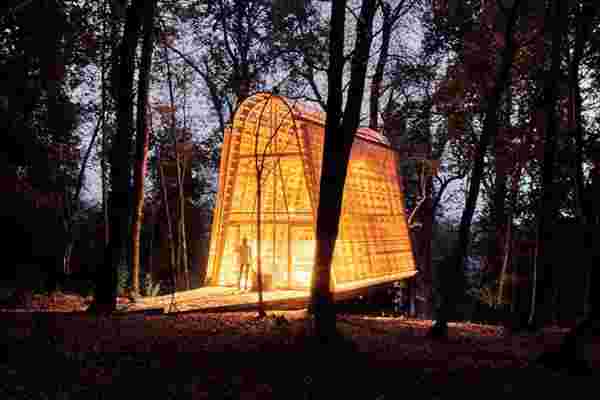
Like a lantern in the night, La Invernada glows underneath the canopies of a forest in Curicó, Chile. The small, cantilever cabin , built for weekend getaways, rests atop a distant river and displays intimate views of the sky from any one of the three floors inside. La Invernada, designed by Guillermo Acuña Arquitectos Asociados (GAAA), comes alive at night with warm, white light and glitters with tree branch shadows during the day, thanks to the structure’s clever textile combination of thermoplastic, pinewood, and mesh building material. Despite the show it gives, La Invernada wasn’t built to stand out, but blend into the forest it now calls home.
During the day, the 580-square-foot home is concealed by rows of dozens of trees that create shadows between the three-tiered cabin’s polycarbonate walls. Then, come sundown, La Invernada turns into a nest full of warmth. Acting almost like a blanket for the home, a mesh curtain wraps all of La Invernada, except for the top floor’s view of the sky, and harbors its warm light in one place, amidst the otherwise dark forest. With cool, rainy winters and long, sunny summers, the design and structure of La Invernada are ideal for Chile’s forest. Polycarbonate, a sustainable and transparent thermoplastic building material, protects La Invernada from Chile’s infrequent, but gusty winds and heavy rainfall. Polycarbonate is known for its ability to withstand large amounts of force, as it’s sometimes preferred over glass materials for constructing long-lasting roofs and shatterproof windows. La Invernada’s laminated Chilean pinewood structure provides the cabin’s rounded ceiling and A-frame final look. The cabin’s skeletal frame allows for it to camouflage into the surrounding clusters of trees, making it hard to believe that three floors make up the interior of La Invernada.
The main floor of La Invernada comprises the dining and living spaces for solo reading time, family gatherings, or even dinner parties in the middle of a dark, wooded forest – that’s one dinner party I’d be sure to RSVP. Guillermo Acuña designed the main living area with a tree’s roots in mind as inspiration – the living room seamlessly merges with the forest. Inside, La Invernada offers even more warmth with a wood-burning fireplace, whose uncovered chimney extends from the living room, past two floors, to the arched ceiling. The kitchen and first-floor bedroom are separated by a bathroom. Then, by climbing a ladder, guests can find accommodations on both the second and third mezzanines, the latter providing unfettered views of the canopied sky above. Opting for a fully-exposed, cantilever deck, La Invernada brings residents from the sky into the forest once more with an outdoor hot tub and timber walkway that leads to the gentle, but running river below.
Designer: Guillermo Acuña Arquitectos Asociados
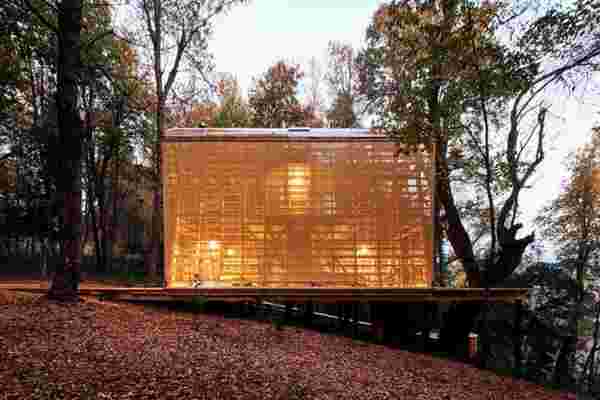
Reflections – World-class Waterfront Living by Daniel Libeskind
Reflections at Keppel Bay presents the new face to world-class waterfront living with its stunning architecture by master architect Daniel Libeskind. A symphony of six glass towers and 11 villa apartment blocks will house 1,160 luxury homes along a 750-m shoreline, all of which enjoy unparalleled views of the waterfront, golf course and lush surrounds. The towers are of 24-storey to 41-storey heights while the villa blocks range from six-storeys to eight-storeys. Combining heroic forms and classical elegance, the towers rise spontaneously as beacons of light’ at the gateway of Singapore’s southern waterfront hub comprising Keppel Bay, Harbourfront and Sentosa. The towers are crowned with lush sky gardens on sloping rooflines, and are linked by sky bridges, providing pockets of open spaces and platforms with near 360-degree views of the spectacular surrounds.
Architect: Daniel Libeskind [ Reflections ] [ Via: Property Report ]
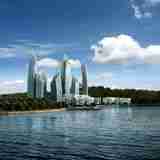
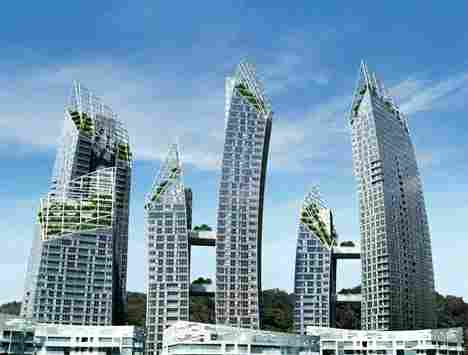
New Metzo College by Erick van Egeraat
The new Metzo College, located in Doetinchem, a City in the East of the Netherlands, houses a school for vocational education as well as public sport facilities. The new building replaces three existing school buildings. On a total gross floor area of 16.000 m2 the school accommodates 1.300 students between ages 12 to 16. The school offers a range of technical and theoretical courses, including health and welfare education.
The project has been initiated in order realize a building which offers space for education and provides for better social cohesion between the different student groups that exist within the vocational education system. The integration of the publicly accessible sports facilities increases the social character of the school and makes it an educational building with an unusually public character.
The building is located in an open green area. The main design objective was to preserve the existing open surroundings as much as possible. This resulted in a compact pyramid shaped building, which integrates into, and respects the surrounding landscape. In addition, the compact building mass also optimizes the internal planning and orientation within the building and it enhances the social aspect of this type of education.
Architect: Erick van Egeraat
